
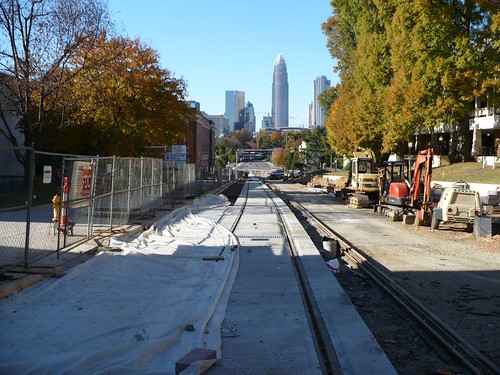

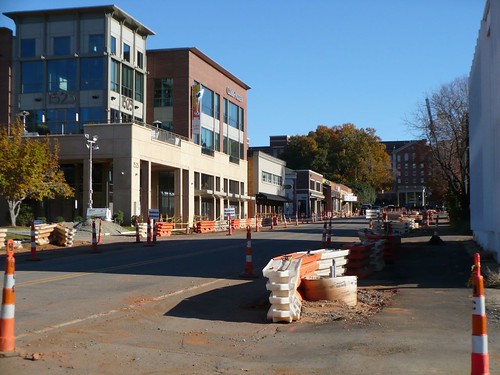
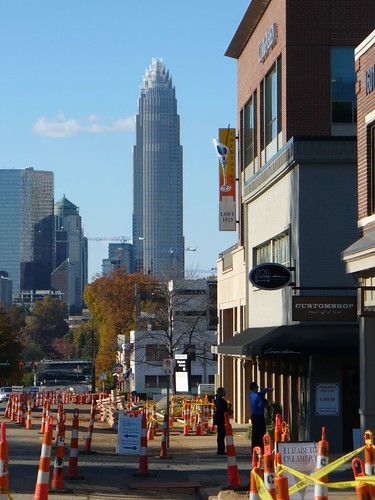





The regional planning and transit bureaucrats who created the latest Triangle transit plan weren't really trying to fashion transportation policy. They were trying to remake the region's economy and land-use patterns according to "Smart Growth" principles that are, in truth, reactionary. They envision urban employment cores, dense residential neighborhoods and rigid commuting patterns based around a 19th century technology, the train, that bear little relationship to reality.Haha didn't anyone tell these guys about Karl Benz in 1885 and his four stroke gas engine. You know, 3 years before Frank Sprague and the electric streetcar. I wonder how many times we have to go over this. But that last paragraph is telling. No citations of real studies or polls (like this one) and all preferences of his own. How come its so expensive to live in Walkable cities? I would venture to guess it is because there is so much demand that prices are being driven up by folks who have money that want this type of lifestyle, making it harder for those who don't to leave the the suburbs. Again, why should we subsidize his suburbia?
While some individuals desire such a lifestyle, the vast majority of citizens, 82 percent by one recent estimate, prefer to live the American dream in a single-family home and travel when and where they want using their personal vehicles. Any transportation plan hostile to clear public preferences is doomed to fail, and to cost taxpayers a great deal in the attempt.
Mayor Pat McCrory cautions against too many competing transit projects muddying the lobbying waters at a state and federal level. The Metropolitan Transit Commission steers most elements of the 2030 plan, including an ongoing assessment of whether to push forward with an extension of a northeast light-rail line and a northbound commuter-rail route.We never worked on three highway projects at the same time, or road projects. It makes absolutely no sense to work on three transit projects at the same time. And there is no other funding source outside of the state and federal level. Money always grows on those trees alone.
This along with similar reports in Phoenix and Denver has been telling us what everyone needs to hear. If you want a strong region, there needs to be a range of opportunities for people to live. I feel like part of the reason for this continued construction on housing near transit is not only that its strong in a storm, but rather there is a lot of catching up to do in order to provide the actual product that people want. The market is so saturated with the same dreck, the pendulum swing is going to be long and hard. I hope it goes far to the other side, but I'm not holding my breath.Development in the Charlotte region has slowed for sure, but real estate analysts say persistent developers are still making things happen.
Look no farther than the Lynx Blue Line, where the Charlotte Apartment Report says 10 communities totaling nearly 3,000 apartments are in various stages of development along the tracks paralleling South Boulevard.
Morgan said new mixed-use transit-oriented development has sprung up along the line. There’s numerous anecdotes about lifestyle changes, he said, including downtown workers living in condos or apartments near rail stations who have sold their cars and avoided insurance, gas and other costs while getting transit subsidies from their employers.
Some of this is from $4 gas I'm sure, but the growth in ridership shows the pull that the light rail line has. Here's my favorite photo from the trip last week. Thursday around mid-day.No.24 Nations Ford, which connects to the Arrowood and Woodlawn road stations: 16,111 then, 23,794 last month.
No. 42 Carowinds, from the South Point Business Park near Carowinds to the I-485/South Boulevard stop: 412 then, 3,589 last month.
No. 43 Ballantyne, which travels to the Sharon Road West station: 3,710 then, 8,259 last month.
No. 44 Fort Mill, from Wells Fargo in Fort Mill to the Arrowood stop: 1,471 to 3,615.
No. 58 Pineville, which runs from the I-485 station to Carolina Place Mall: 12,294 to 16,318.
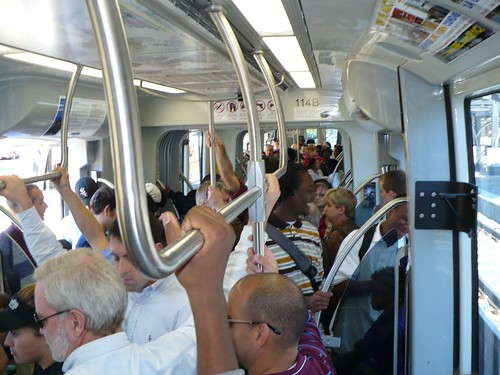
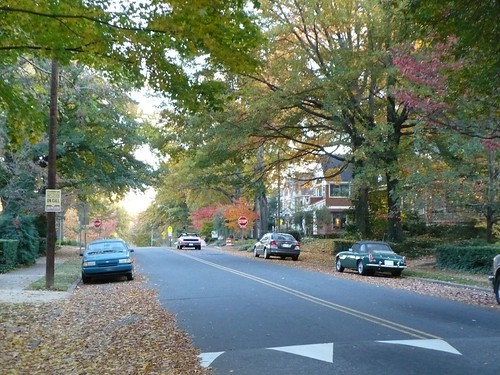

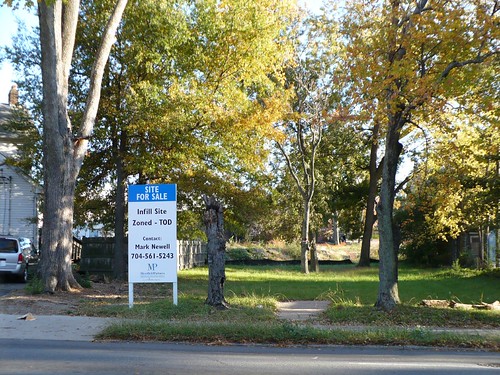

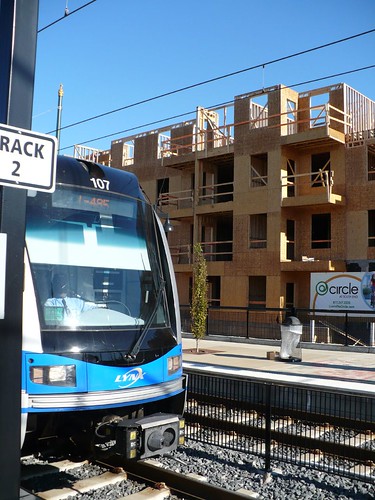
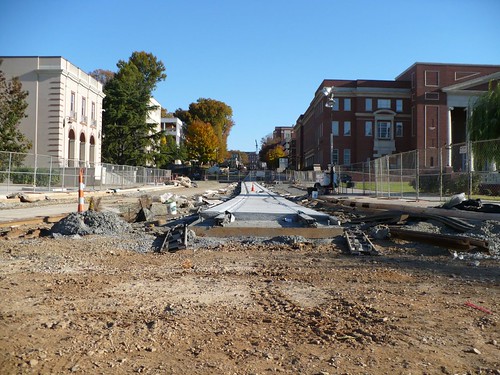


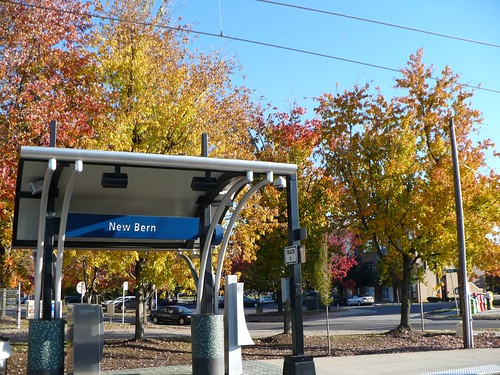

...Parker said he'll likely brainstorm other ways to raise money so rail lines can be built sooner.After years of spending on things other than transit, the Mr. Parker has the right idea about trying to catch up, which would make it cheaper in the long run. Their 10 year wait for the first line did nothing but cause project inflation and almost lost them thier funding source all together with the referendum last year. Yet Pat McCrory, the Mayor, Gubernatorial candidate, and staunch transit supporter, is against the idea of using any funding outside of the current half cent funding stream.
...
With the cost of raw materials rising, Parker believes it's important to build Charlotte's rapid transit in the next decade, rather than by 2035, the finish line in the current plan. If the federal government isn't willing to send more money to CATS, Parker said he may bring the Metropolitan Transit Commission and the Charlotte City Council options.
McCrory said this week he doesn't want to consider a new tax or bond to build the transit system sooner. CATS already wants to use some property taxes to build the commuter rail line, and the city of Charlotte is considering the same for the streetcar.
“We'll have to live within the confines of the half-cent sales tax,” McCrory said. “During these economic times we'll have to be both economically and politically pragmatic. And at times, patient.”
In transit funding, patience costs money, and there are other ways to pay for transit projects. Because transit creates value that often isn't credited to it, there needs to be more attention paid to the value is created and capturing it to pay for the project. Putting a cage on it isn't the answer.
Indianapolis spends far less than these other cities on government -- and consequently spends far less on such things as parks, public transportation, the arts and libraries, amenities that some people view as optional but that experts see as critical to making a city vibrant and competitive.
Indianapolis' spending choices underscore two core community values: thrift and an affinity for small government.
It sure explains a lot and offers a vision of what a more libertarian type future would be like. The point seems to be that they don't value the commonwealth ideals as much as regions like Portland and Seattle who value parks and libraries.
"The unwillingness to gut it up for big expenditures made it hard to keep pace with other cities," Hudnut said. "It's very tough to fund some of these necessary improvements if you campaign on a no-tax mantra."
The no-tax mantra is alive and well as we know from the famous Grover Norquist wish to shrink government so much that it could be drowned in a bathtub. But this no-tax policy also seems to be killing needed services and common goals. Unfortunately, people don't quite understand the value of networks when thinking about the beginning of transit or parks for that matter. It's all about what benefits me now and not the Universe of benefits but rather the MEniverse.
Melyssa Donaghy, an anti-tax activist with Hoosiers for Fair Taxation, acknowledges as much. "I don't use the parks except the Monon Trail," she said. "I don't think it's affecting my quality of life. What's affecting my quality of life is the ability to pay my bills."
Sure it might not be affecting your quality of life, but what about others? What about things that do affect your quality of life that others don't want to pay for. This comes up with transit as well. Why should I pay for that if I don't use it. Well, the people who will take transit often pay for your roads, why should they do that? If I take BART to work every day, why should I pay for the new Bay Bridge span? It doesn't benefit me directly. Therein lies the problem.
I think this answers why older rust belt cities are doomed to die a slow painful death. Places like Cincinnati and Indianapolis will never be havens for the creative class unless they start investing money in their cities instead of being misers. Being cheap in the MEniverse is easy. Investing in all aspects of community, well that takes civic pride and a willingness to provide common wealth for the common good.
Parker wants to bundle three projects. The first is an 11-mile extension of the Lynx to University City, which is now projected to cost $900 million. The commuter rail line to the Lake Norman area could cost between $250 and $310 million. CATS is also penciling in $50million to improve the existing light rail line. It wants to extend station platforms to handle three-car trains and also wants to buy additional rail cars.It seems like these package deals are starting to catch on as regions are seeking to build more than one line at a time. The FTA is going to get more of these after they made the deal that they did with Salt Lake City paying for 20% of their four lines.
In August 2007, FTA and UTA executed a Memorandum of Understanding to set forth their mutual expectations for Federal financial participation in two of five projects that comprise UTA’s “Transit 2015 Program.” UTA was seeking a combined $570 million in Section 5309 New Starts funding for the Mid-Jordan and Draper LRT extensions. In return, UTA made a commitment to build, by 2015, the West Valley City and Airport LRT extensions, as well as the South Front Runner (commuter rail) extension without Federal financial assistance. The current total capital cost estimate for the five projects in the Transit 2015 Program is $2.85 billion.Now CATS will try a similar deal getting more out of the process. What this tells me is that the process that exists now doesn't really work for regions. They are looking to fill in the gaps that were missing in the last 60 years and there is just not enough money from any source to do it.
However, average weekday ridership on CATS’ light-rail system fell 3.2 percent last month to 16,357 from 16,895 in July.
MTA officials denied that they lowballed Orange Line ridership predictions but conceded that their forecasts might be more art than science. "We didn't put it into a computer model," said Rod Goldman, the MTA's deputy executive officer for service development. "A lot of it was our educated guesswork based on our experience."Charlotte's mixed use market is doing better than single family homes. Seems to me like this might be from lack of supply over the years. Complaints of expense just prove this point. From the Charlotte Observer:
“There's an immediate crisis feeling about the price of gas, but there's also a different living preference now,” said Laura Harmon, economic development program manager for the Charlotte-Mecklenburg Planning Commission. “Those of us who might be baby boomers didn't have those options. But now the millennials and so forth are wanting to live differently.”As noted in the guest post by J.M. it will be interesting to see how Norfolk's light rail line comes out. But while they were pushing forward, their sister city rejected the idea. Now the local paper thinks its time to get back on the train.
The Starbucks with a drive-through window at the edge of downtown? That one stays. So does the Starbucks at the other end of downtown inside of Safeway. But the coffee house at the most visible corner in downtown? The store that was supposed to anchor a cornerstone redevelopment project? It’s closing.
...
Ultimate responsibility, though, lies with the community. Redding is a town where people rush to the newest franchise restaurant. Earlier this year, they lined up overnight for the opening of a Chipotle in a rebuilt strip center. Seriously. It’s a town where Wal-Mart, Costco, Target and Home Depot have big boxes within walking distance of each other – although you’d take your life in your hands trying to make the trip on foot.In other words, most people who live in Redding don’t care about having a vibrant downtown full of local flavor. And no one – including an urban planning journalist who thinks he knows better – can make them care.
 Seems to me that it's easier to ride and more convenient than other busways that only increased by 4% in a corridor that has greater population. Also, we got a comment from a reliable anti-rail buddy Tom Rubin in the last Orange Line post. He's most recently been trying to work in Milwaukee for the Reason Foundation but was shutdown by Len Brandrup of Kenosha Transit. I thought his joke at the end of his comment on the last Orange Line post was quite funny. What do you all think?
Seems to me that it's easier to ride and more convenient than other busways that only increased by 4% in a corridor that has greater population. Also, we got a comment from a reliable anti-rail buddy Tom Rubin in the last Orange Line post. He's most recently been trying to work in Milwaukee for the Reason Foundation but was shutdown by Len Brandrup of Kenosha Transit. I thought his joke at the end of his comment on the last Orange Line post was quite funny. What do you all think?It's gotten so bad in fact that the local paper has asked everyone to tone it down, something which they were enablers of and allowed to get out of hand even in their own paper. I have never seen an article on the facts or benefits, just who said what.In the most recent attack circulated via e-mail last weekend, a satirical illustration and text compared rail advocates to al-Qaida leader Osama bin Laden and the Nazis. Hannemann administration officials said the e-mail "crosses the line."
The e-mail, with the subject line "People in Hawaii Are Too Stupid -- DON'T Let Them Vote on Rail," features a photo of Osama bin Laden with the message, "People of Oahu, you should NOT be allowed to make any big decisions in the ballot box. Only Mufi and his friends should decide."